The following essay was originally written for Amazing Stories during its Wizards of the Coast phase and while under the editorship of Kim Mohan in November 1998 and was published in the magazine in 1999. It is reprinted here by permission of the author. (Mr. Silverberg requested that the dates herein be updated from the original. I’ve chosen to only do so twice – once at the very beginning to set the time frame – because I felt that the edits would interfere with enjoyment of the piece.)
The Observatory
by Robert Silverberg
It is, I am somewhat appalled to realize, just about fifty years this month since I first bought a copy of AMAZING STORIES. (Ed Note: 63 years now.) In that half century the magazine and I have both gone through more than a few significant changes of format and policy, and yet here we still are, AMAZING and I. It was the great ambition of the small boy who managed to scrape together 25 cents in December of 1948 to purchase the issue of AMAZING dated February, 1949 to succeed, some-day, in having a story of his very own published in that magazine. Well, and so he did; and how I wish I could drop him a line, back there in what now seems the Pleistocene, and tell him how thoroughly he was going to see all his pre-adolescent hopes and dreams fulfilled!
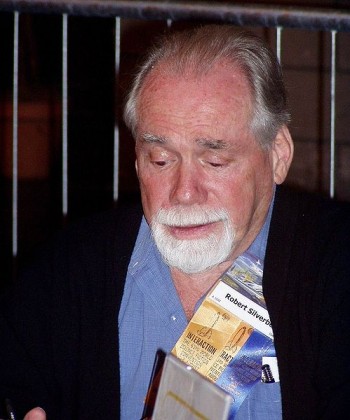
Fifty years. Gone in an eyeblink.
I had been reading science fiction in book form for about three years before I discovered that the stuff was published also in magazines. I began when I was about ten — with Jules Verne’s 20,000 Leagues Under the Sea — moved on quickly to Wells’ The Time Machine and Twain’s Connecticut Yankee, and then to the primordial s-f anthologies, Wollheim’s The Pocket Book of Science Fiction and the Healy-McComas Adventures in Time and Space. The copyright pages of those two books gave me my first clue to the existence of publications called AMAZING STORIES and ASTOUNDING SCIENCE-FICTION and such, and in the spring of 1948, insatiably hungry now for more of this wondrous kind of fiction and only mildly repelled by their garish names, I began to look around for them.
AMAZING was not actually the first such magazine I bought. That distinction goes to WEIRD TALES, whose July, 1948 issue I picked up because of its marvelous cover painting (a unicorn pursued by two winged serpents across a psychedelic sky) and because its lead story, Edmond Hamilton’s Twilight of the Gods, was a retelling of the good old Odin-Thor-Loki stuff that had given me my first taste of the fantastic years before. I loved it, but the rest of the issue was taken up with vampire tales, ghost stories, and other things not much to my taste. A few weeks later I peered into an issue of ASTOUNDING, but it seemed very sober stuff indeed, with a feature article full of wiring diagrams, and I decided to hang on to that month’s disposable income. (A quarter was a lot of money in 1948, especially if you were completely dependent on your father’s largesse for each one you got.)
But then — then — near the end of the year —
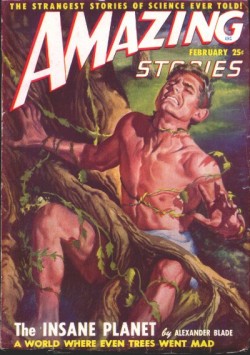
There was the February-dated AMAZING blazing out of the magazine rack in the candy store across the street from Junior High School 232. Its cover, illustrating a story called The Insane Planet, by Alexander Blade, showed an agonized loincloth-clad man writhing in the grip of a leafy bough. A World Where Even Trees Went Mad, cried the cover caption. There were stories as well by Rog Phillips, Craig Browning, and three other writers, none of whose names I had encountered in the handful of anthologies I had read thus far. I put down my quarter and gleefully tucked the magazine in my briefcase.
That night, when I should have been doing my Latin homework, I reveled in the big, rough-edged, cheaply printed magazine I had bought. The Blade story was quite fine, I thought. But the true masterpiece of the issue was Rog Phillips’ short novel M-Bong-Ah. It took place on Venus: mysterious tropical Venus, much like steamy Africa only ever so much stranger, inhabited by a race of eight–foot-tall blue-skinned hairless humanoids with voracious libidos. My own pubescent libido was heating up nicely that year, and the illustration on page 31 of Gretta, a gigantic Venusian woman in a nearly topless harem costume, was an overwhelming sight. Gretta wished to impart the folkways of her people to our spaceman hero. “She began her dance. It was a slow, rhythmic movement with short steps. ‘This is the dance of M-bong-ah,’ she explained. ‘It is the dance of the temple girls to the Gods of Venus….’ Suddenly, she fumbled with the buttons on her dress. Then she pulled it off in a hasty motion, revealing her wonderful, lithe body. ‘I cannot dance with clothes on,” she said.”
By page 33, where we got to see a good deal more of that wonderful, lithe body, I was in love with Gretta. And with AMAZING STORIES.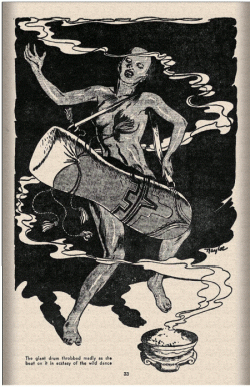
Though M-Bong-Ah left such a mark on my imagination that I began writing my own sequel to it that very night — not on paper, but in my mind as I lay in bed, for how could I sleep after such an experience? — there was another section of the issue that caught my interest the next day, a column called “The Club House,” written by the very same Rog Phillips who had penned that masterly story. The column dealt with science-fiction fandom — a world of people who shared my newfound enthusiasm for the fantastic, and actually got together in conventions to talk about science fiction, and published their own little magazines, things called “fanzines,” with tantalizing names like Chronoscope and Kotan and Ploor. Fascinating! Entrancing! Irresistible! For an investment of two bits I had changed the entire direction of my life.
I bought the next issue of AMAZING, of course (The Chemical Vampire, by Lee Francis, and the unforgettable novella The Swordsman of Pira, by Charles Recour) and I ran over to Jackson’s Book Store — where in an earlier phase of my life I had bought armloads of back issues of THE NATIONAL GEOGRAPHIC MAGAZINE to further my studies of exotic lands — and purchased from that grubby and sinister merchant a thick stack of old AMAZINGs at three issues for a quarter. Here was Titan’s Daughter, by Richard S. Shaver, which the cover caption told me was A Smashing Sequel to the Sensational ‘Gods of Venus’, and Arthur Petticolas’s Dinosaur Destroyer, The Story of Daarmajd, the Strong — Mighty King of the Prehistoric World, and Alexander Blade again with The Brain, (A Giant Calculating Machine Decides to Rule the World!) and — and —
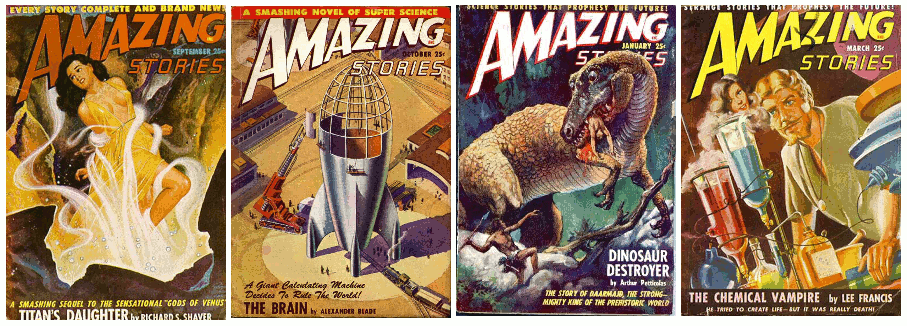
Well, I was lost. I collected all the AMAZINGS I could find, back unto the immensely thick issues of 1942, and then the archaic-looking ones of 1934, and the large-format ones of the late 1920s. Those cherished magazines seemed incredibly ancient to me, although the oldest of them dated back only fifteen or twenty years. The Jimmy Carter presidency is more distant in time from our era than those old magazines were then to mine.

Yearning to become a science-fiction writer myself, I began feverishly to scribble little stories and send them to the editor of AMAZING in Chicago. (I got them back with the speed of light.) I subscribed to a few fanzines, and by the fall of 1949 I was publishing my own, an execrable and illegible little thing called Spaceship. I started to read AMAZING’s virtually identical companion magazine, FANTASTIC ADVENTURES, and then ASTOUNDING and STARTLING and all the other s-f magazines of the day. Gradually, as I ripened into a worldly-wise 15-year-old, I began to see that Rog Phillips and Alexander Blade and Charles Recour and my other literary heroes of 1948 and 1949 were mere penny-a-word hacks, and stories like M-Bong-Ah and The Brain were the veriest crude junk, suitable only for impressionable children like my own self of two years before. But I forgave myself for my youthful lack of discrimination.
The home office of AMAZING and FANTASTIC ADVENTURES had moved from Chicago to New York late in 1949, and Ray Palmer, the magazine’s long-time editor, did not choose to go along. His place was taken by shrewd, hard-boiled Howard Browne, a well-known mystery novelist who had written some decent adventure stories for Palmer’s magazines. Browne dutifully maintained AMAZING’s juvenile tone for a couple of years, since the magazine had attained the highest circulation in the s-f field by serving up action fiction for boys. But his heart was in publishing more sophisticated material, and in 1952 he killed off FANTASTIC ADVENTURES and began an elegant-looking companion simply called FANTASTIC, with slick paper and stories by the likes of Ray Bradbury, Isaac Asimov, and Theodore Sturgeon. The following year he converted dear old pulpy AMAZING to the same handsome format, banished the high-volume hack writers, and added Robert A. Heinlein and Arthur C. Clarke to his new list of high-octane contributors.

It sounded good, but I wondered if Browne could really deliver the goods. The wide-eyed pre-adolescent of 1948 was now the suave college kid of 1952; my M’Bong-Ahphase was over and I believed (wrongly) that Browne’s previous predilection for simple-minded adventure tales showed him to be unqualified to edit an s-f magazine for mature readers like me. I said so, quite acidly, in one of the fanzines to which I was now a regular contributor. Browne actually replied with an essay of his own, remarking, “These jackals grow too bold,” and going on to refute every point of my attack. I was surprised that he had even deigned to notice.

We jump now three years. I was as eager as ever for a career as a science-fiction writer; I was turning out stories at a steady pace despite the distractions of college life and had actually begun getting a few of them published. By the spring of 1955 I had sold my first novel and acquired a literary agent. But progress was slow; sales were few and far between.
That year a well-established s-f writer named Randall Garrett turned up in New York and rented a room in the same apartment building near Columbia University where I was living. “You won’t get anywhere in this field unless you know the editors personally,” he said, and took me downtown to introduce me to them. Among those we visited was Howard Browne of AMAZING STORIES. “This is Bob Silverberg,” Garrett said. “He’s one of the hottest new writers around. You need to be publishing him.” And I handed Howard a story called Next Door, from the e.e. cummings line, “There’s a hell of a good universe next door — let’s go!”
It wasn’t a great story. My own agent had declined to market it, calling it too thin and elementary to be salable. Even after I rewrote it for him, he sent it back and advised me to put it aside, saying the idea “lacked strong story possibilities.” But Howard Browne glanced quickly through it as Garrett and I sat there in his office that August afternoon. “Sure,” he said. “I’ll buy it. Forty bucks.” It ran in the January, 1956 issue of AMAZING under the title of “Hole in the Air.” It had taken me just seven years to make the transition from wonderstruck new reader to cool, calculating professional.

To my own great flabbergastation I discovered that I had moved right into the sort of slot that had been occupied, in AMAZING’s Chicago days under Ray Palmer, by the men who wrote under the names of “Rog Phillips,” “Charles Recour,” and “Alexander Blade.” For Howard Browne, after a couple of years of trying to run a quality s-f magazine and seeing circulation drop sharply, had stopped publishing Heinlein and Bradbury and that ilk, and had gone back to the old policy of two-fisted adventure fiction, written (I now knew) by a staff of hired hands who turned in their stories on a quota system, so many thousands of words a month, everything bought sight unseen and published virtually without editing.
Instead of reconstructing the old Chicago stable of writers, Browne was busy gathering a New York-based staff of high-volume writers about him who would show up every Monday with the previous week’s output, collect their checks, and go home to get busy on the next undying masterpiece. With the aid of Randall Garrett’s sponsorship of me, I landed a place in that crew. One cent a word, $50 for a 5000-word story, $150 for a 15,000-word lead novelet, a guarantee of 50,000 words purchased every month, nothing rejected so long as I did a decent job within the confines of the basic story formulas.
I was in my senior year at Columbia, about to get married, and the offer of a steady, predictable income stream was a Godsend. Each week, without fail, I brought Howard a story or two, the very same sort of straightforward hero-villain stuff that had hooked me on AMAZING in the era of Alexander Blade. Once in a while I craftily slipped in a manuscripts from the pile of those I had unsuccessfully tried to sell to the higher-grade s-f magazines over the past couple of years, stories of rather greater literary aspiration than the ones I was doing for AMAZING now, but Howard didn’t object to their lack of pulpiness, since in fact I don’t think he read the stories we delivered at all.
Because just a handful of writers were producing all the copy for both AMAZING and FANTASTIC (submissions that came in from unwitting outsiders were returned unread), pseudonyms were a necessity. The June, 1956 issue of AMAZING contained Robert Silverberg’s Entrance Exam, but also a Garrett-Silverberg collaboration called Gambler’s Planet under the byline of Gordon Aghill. July saw another Aghill opus, Catch a Thief, plus Run of Luck by Calvin Knox — me — and Stay Out of My Grave by Ralph Burke. (I could not tell you today, even at gunpoint, what those stories were about. But the three of them paid a whole month’s rent with something left over.) The August issue gave the world the memorable Garrett-Silverberg novella The Beast With Seven Tails, which we wrote as Leonard G. Spencer, and I’m in the issue as Silverberg and Knox as well.

And so it went, month after month, a ton of stories, Garrett and I writing all of AMAZING practically singlehanded, with some help from the veteran pro Milton Lesser and a new kid named Harlan Ellison. I hit one big high point — or, perhaps, a low one — with the August, 1956 issue of FANTASTIC, in which four of the six stories were my doing, led off by my dazzling tale, Guardian of the Crystal Gate, in which stylistic echoes of M-Bong-Ah can readily be detected. Some months later came another great moment when something of mine appeared in print under the name of Alexander Blade –for, as it happened, old Alex was nobody in particular, simply a house name that the editor hung on stories that needed pseudonyms in a hurry. And so I came full circle: the little boy who had been dazzled by those great Alexander Blade stories of 1948 had within the space of nine years turned into Alexander Blade himself.
After I had been a staff writer for Howard Browne’s AMAZING for a year or so, Howard pulled a lovely little surprise on me. I came into his office to deliver my latest batch of stories and he pulled from his desk the issue of the fanzine in which my younger self had denounced him so cuttingly in 1952. “Remember this?” he asked. He had known all along, of course, that the Robert Silverberg whom he had taken into his editorial bosom was the very same viper who had attacked him with such vitriol a few years before. I muttered something sheepishly about the impetuousness of youth, but of course he had long since forgiven me for my adolescent indiscretion, and he went on buying stories from me by the carload for the rest of his editorial career.
All that was forty years ago. Howard resigned eventually and went back to writing mystery novels — he’s still doing it, I hear, at the age of ninety or so (ed. note: Howard Browne died 10/28/1999) — and by 1959, when Cele Goldsmith had become editor, the policy of having the magazine entirely written by a staff of three or four hired hands had given way to the more orthodox arrangement of seeking contributions from any qualified writer. Which is why the July, 1959 issue has stories by Robert Sheckley and Ray Bradbury in it, and quite a good one, not hackwork at all, by Randall Garrett, and — yes — the short novel Collision Course by Robert Silverberg. For I had survived the transition and was still submitting — and selling — stories to AMAZING.
Formats, policies, even publishers have come and gone for AMAZING many times since then. Cele Goldsmith’s regime gave way to that of Joseph Ross, who was replaced by Harry Harrison and then Barry Malzberg, and after him Ted White. Eleanor Mavor followed White and George Scithers followed her, and then came Pat Price and now Kim Mohan, who has guided the magazine for two different publishing houses.
And, decade in and decade out, through thick and thin, there’s never been a time when I haven’t been a contributor to AMAZING. Some virus got into me, I suppose, that wintry day in 1948 when I found myself staring at the issue that was to bring Rog Phillips’ M-Bong-Ah and Alexander Blade’s The Insane Planet into my life, and I will never be able to rid myself of it. Even now, old and weary and white-bearded as I am, I find myself beginning to sketch out yet another story for AMAZING, the new and shiny incarnation of it that Kim Mohan is operating. This magazine and I have been together, somehow, man and boy, for fifty years: why stop now?
I had a lot of fun reading Bob’s piece. My story took place a couple of decades after his own, but with the exception of the 7 year interlude between fan and pro, they are so very similar it was uncanny.
Perhaps even more so when I mention that Mr. Robert Silverberg himself contributed greatly to my evolution as a fan.
One of the very first anthologies I picked up was the original The Science Fiction Hall of Fame, edited by Robert Silverberg.
It is a nicely thick volume and it arrived right on time (1970). Just a few years before I’d started buying books at the Bookmobile.
It was and remains one of the best and most influential anthologies in the field. Short stories all, slightly more than half were selected by the members of the Science Fiction Writers of America from works that had been published prior to 1965, the first year that the Nebula Awards (themselves presented by SFWA) were offered.
Bob himself chose the remaining eleven stories. I’ve listened but haven’t heard a single complaint over the past 40+ years. (I’m proud to say that I still have my well-worn first edition copy, and four or five newer ones as well.)
If you have not acquainted yourself with this volume, you must do so. It covers the field from Stanley G. Weinbaum’s A Martian Odyssey (1934) to Roger Zelazny’s A Rose for Ecclesiastes. (1963). This span represents more than time. It represents just about every theme, style, trope, plot and character you will ever run into in science fiction. Every single one written masterfully by a master. It is a veritable indispensable guide for both writer and fan. (Someone, sometime, somewhere will hunt you down and do horrible things to you if you dare call yourself a fan without having read this anthology. Seriously.)
It was this book that set my relationship with Mr. Silverberg for the next several years. He’d put together a fine collection and written a very informative introduction, so I continued to pursue his editorial and anthologizing persona through a number of one-shots and series with titles like Alpha (1 thru 9), New Dimensions (1 thru 12),Tomorrow’s Worlds, To The Stars and more.
A few years on and I had the pleasure of meeting and working with (to use the phrase loosely) the man himself. I’m sure he doesn’t remember it, but like many Worldcons before it and for many Worldcons to follow, Bob as going to be the Toastmaster at the 1977 Hugo Awards Ceremony and I was managing it for the convention.
I actually got to coordinate with Bob Silverberg! The science fiction author who was so highly regarded and respected by the best in the field that year after year they selected him to say nice things about them and hand them their awards. Occasionally they let him hand one to himself.
It’s unfortunate, but I don’t remember much about our encounter – I was awfully busy and stressed: I do know that I explained how the slide show presentation was going to work, what his cue would be and that all he had to do was ask if he needed anything. We’d shaken hands upon introduction and as I walked away I vowed that when I’d grown up enough to grow a beard and mustache, I’d have one just like his – a natty goatee. (I do, but it isn’t nearly as natty as Roberts’. Not nearly as white either, though I am catching up.)
It took me a while but I finally realized (back then) that Robert Silverberg had been one of the very first science fiction authors I had ever read. He’d sold a couple to the Scholastic Book Service – Lost Race of Mars and Revolt on Alpha C. Yep – still have them.
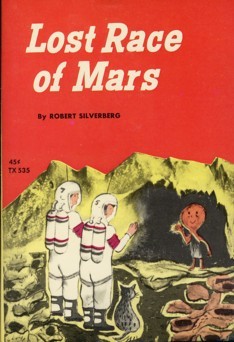
Bob readily admists (and lays out in some detail above) that there were two distinct phases to his career. The first half when he penned a monstrous number of stories per month and the second half, during which he has received a great deal of critical acclaim. Two from the latter half are perennial favorites – Up the Line (a wonderful time travel story) and Dying Inside (nominated for the Hugo, Nebula and Locus awards).
And so much more; I remember the anticipation when Shadrach in the Furnace was being serialized in Analog; Thorns, Nightwings that seemed to elevate his reputation to even greater heights; The Stochastic Man, A Time of Changes, The Book of Skulls – all published within less than a decade and ALL of them nominated for either the Hugo, Nebula or Locus Awards (and frequently all three).
I’d be remiss if I didn’t mention both Lord Valentine’s Castle and the Majipor series. Perhaps his most enduring and popular series, the first novel (Lord Valentine) would win the Locus Award and be nominated for a Hugo for Best Novel. Begun in 1980, it has been a steady presence in the field since,
Bob would ultimately become SFWA’s 21st Grand Master, an honor much deserved, gathering up three Hugos and five Nebula awards along the way.
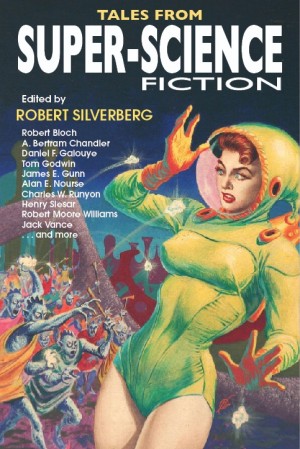
Bob is still going strong. His ‘Official Unofficial” website can be found here at Majipoor.com and – coming full circle (at least for me) – amongst his latest efforts is the retro anthology Super Science Fiction, a collection of hand-picked stories from the pulpy pages of that 1950s era rag of the same name, now out from Haffner Press, (where Bob unwittingly does me yet another favor by reprinting a story by A. Bertram Chandler).
Thanks for it ALL, Bob!


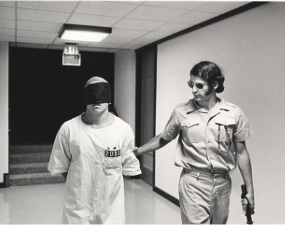





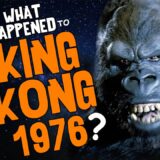

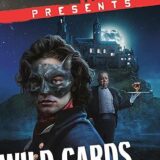
Recent Comments